The tactile nature of vinyl records is both what makes the format appealing, and also challenging. Well cared for records can last a lifetime, while poorly looked after records will quickly become worthless and unlistenable. For the best listening experience, consider following these key points to help look after your vinyl records and preserve them for many years to come.
Storage
Step one is the proper storage of your precious records when they’re not in use. Firstly, always store your records vertically and away from extreme temperature or humidity changes to prevent warping. Never lay your records flat as this is a sure way to warp them over time. Secondly, dust and dirt are the audiophiles’ worst enemy, and the best weapon here is prevention. Always store your records in their sleeve and place them inside the cover. The aim of the game is to keep the amount of time that a record is exposed to airborne dust and dirt particles to an absolute minimum.
Outer and Inner Sleeves
Most records ship with very basic paper inner sleeves and no additional outer sleeve protection. So to really make sure our records will last the test of time, we’ll want to consider making a couple of upgrades.
It’s best to upgrade those basic paper outer sleeves for a good quality polyethylene lined inner sleeve. The MoFi sleeves are a good place to start, as they are readily available and very cost-effective.
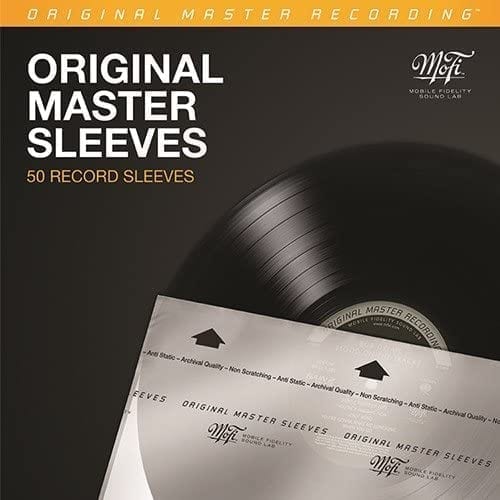
Cheap paper inner sleeves offer little protection to a record. They leave paper flakes over the record surface and can often lead to scuffs and scratches over time. This issue isn’t helped by the complete lack of antistatic properties, which means the record can easily cling to the white paper and lead to scratches as the record is pulled in and out of the sleeve.
A good quality outer record sleeve will help protect the record further from dust, while also helping to preserve the cover art from wearing out every time you pull a record from your library to play. Again, MoFi offers a good affordable solution here, but I’ve been increasingly impressed by a new player on the market by the name of Vinyl Storage Solutions.
Vinyl Storage Solutions (VSS) are a Canadian-based company with a real focus on material quality and product engineering. Their new dual-pocket outer sleeves, for example, allow you to store the jacket in a separate compartment, which means you can protect the artwork while still retaining easy access to the record. It’s a really clever design – check out our full review to learn more.
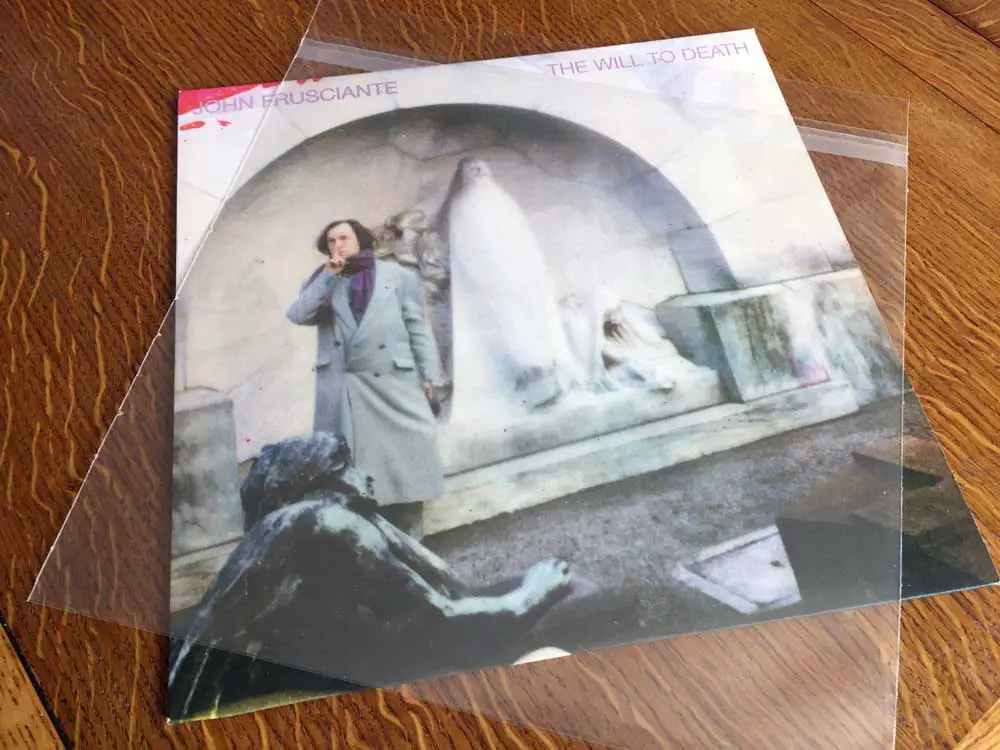
Far from a one-trick pony, VSS now also produce a great range of inner sleeves, so if high-quality materials sourced from North America appeals, you’ll love what VSS offers.
As a Sound Matters reader, you can benefit from 10% off your purchase when you buy directly from the VSS online store. Simply use the code SOUNDMATTERS10 on checkout. This code is a one-time use only and can’t be combined with other coupons or discounts. Discount is for product only and doesn’t apply to taxes or shipping costs.
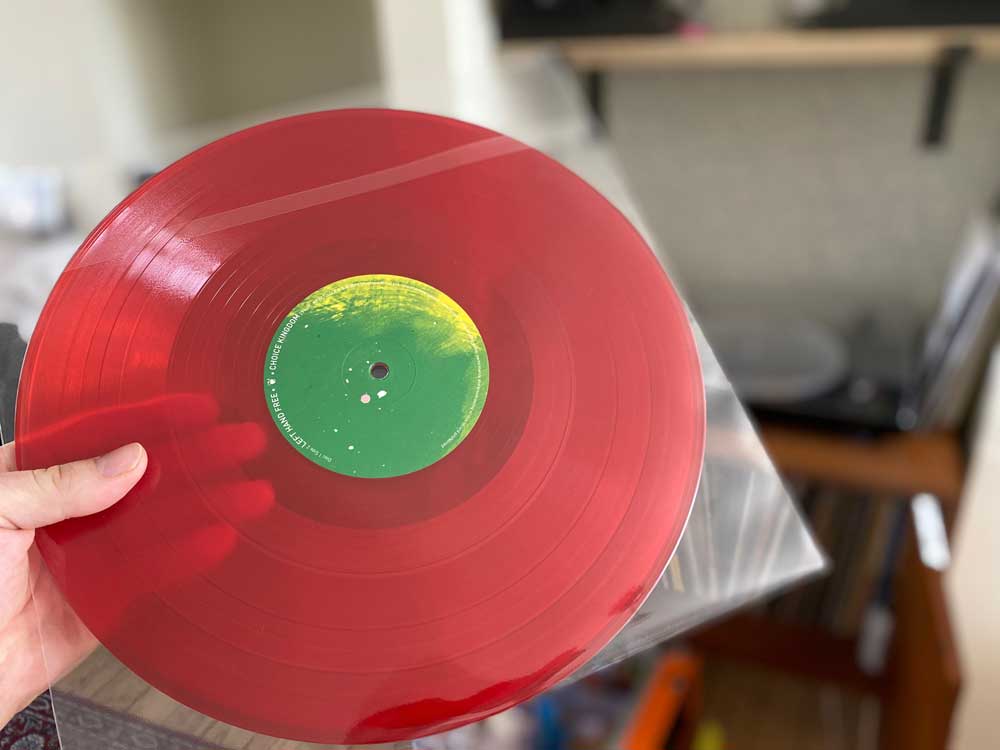
Record Handling
OK, so this one might sound a little like teaching you to suck eggs, but I think it’s important we cover the basics. If dust and dirt are the vinyl enthusiasts’ worst enemy, you’ll want to avoid getting them so dirty in the first place by keeping your mitts off those delicate grooves!
No matter how clean we keep our hands, the natural oils from our skin are no good for the record surface. So the long and short of it is, we want to avoid touching any part of the record that contains a playable groove. Instead, handle your record carefully by the edges and the inner label. This can be tricky when we’re pulling the record in and out of the sleeve, so we need to take extra care to ensure our finger-tips aren’t slipping onto the beginnings of side A and B.
Use a Carbon Fiber Record Brush Before & After Playback
Once we’ve removed the record safely from the sleeve and placed it gently onto the turntable platter, it’s best to include a carbon fiber record brush as part of your day-to-day playback ritual.
There is much debate about the correct way to use a carbon fiber record brush, but in short, we want to ensure we use it before and after the playback of each side. Making this a habit will not only protect our records from dust, but also extend the life of our stylus at the same time.
To learn more, read our guide on ‘how to correctly use a carbon fiber record brush’.
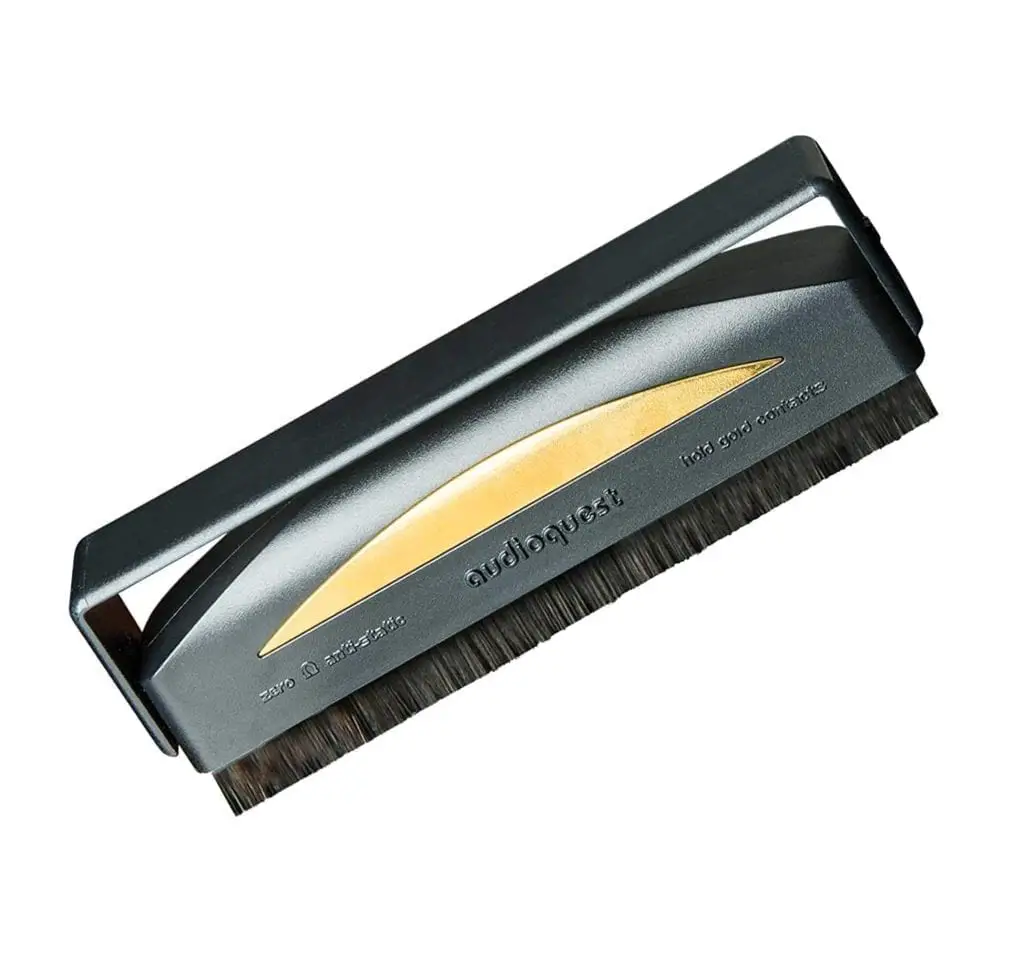
Cleaning Your Records
No article on record care would be complete without touching on the thorny topic of record cleaning. Even the best cared for records will occasionally benefit from a quick clean, and if you’re buying used records, you will invariably want to clean them before they grace your turntable. Incidentally, the topic of ‘how to clean vinyl records‘ is once of the most popular topics with Sound Matters readers, so for the purpose of this article, we’ll stick to the basics.
Why Should You Clean Vinyl Records?
Cleaning becomes particularly important if you buy your records used; as dirt, oil, and dust will undoubtedly be present, causing poor sound quality in the form of pops and clicks. Dirty records will also damage your stylus over time. Surprisingly, new records also benefit from a quick clean before the first playback as they are often contaminated right from the factory with release agent and other dirt from the manufacturing process.
Note: The cleaning methods listed can improve audio clarity, but will not restore damaged records. A damaged or worn record will remain damaged despite any cleaning process. Always handle your records with respect, and maintain your turntable to reduce wear.
Cleaning Vinyl Records By Hand
If you’re on a budget, you can get great results with hand cleaning methods. Place your record on a soft, lint-free surface and apply a record cleaning solution. Tap water should be avoided as it can contain mineral deposits and/or limescale that can damage your record. I personally use GrooveWasher record cleaning solution, which is specially developed to effectively clean vinyl records and not leave any residue. You can purchase the handy kit version (as pictured below), which includes the beautiful walnut cleaning pad and display block, or instead opt for their cost-effective starter kits. (The core cleaning solution is the same in both).
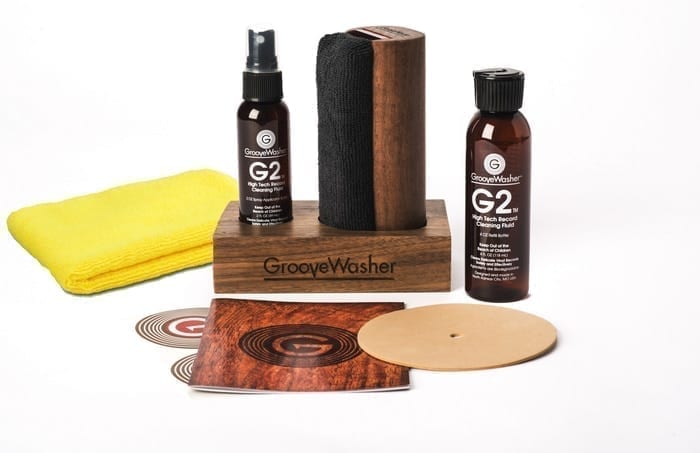
Read our full GrooveWasher review (including before and after audio samples), here.
As a Sound Matters reader, you can also benefit from 10% off your purchase when you buy directly from their online store. Simply use the code SOUNDMATTERS10 on checkout.
If GrooveWasher is unobtainable where you live, I can also recommend the Vinyl Revival cleaning kit. This solution is safe and alcohol-free, but does require a two-step cleaning process (clean and rinse).
Record Cleaning Machines
By far one of the most effective ways to clean records – particularly en masse – is to use a record cleaning machine. Depending on your budget, there are several routes you can go down.
The first and most cost-effective method is to use a manual record cleaning machine, such as the Spin Clean Record Washer. Compact machines, such as the Spin Clean are a great way to batch-clean a lot of records in one sitting. They work by essentially giving your records a bath using a cleaning solution and distilled water. All you have to do is gently spin the record through the cleaning solution while the built-in cleaning pads do the heavy lifting. You can read and watch our full review of the Spin Clean, here.
Vacuum Record Cleaning Machines
A vacuum record cleaning machine will set you back a few more pennies than the fully manual spin-clean, but the fact is, they are also far more efficient. Instead of relying on the dirt and dust to drop to the bottom of the cleaning tank, a vacuum record cleaner will physically extract the contaminated cleaning fluid from the record surface. If you can spare the money, the results are impressive. You’ll also save a lot of time and effort when batch cleaning large collections. Check out our recent review of the Pro-Ject VC-S2 for a good example of this cleaning method in action.
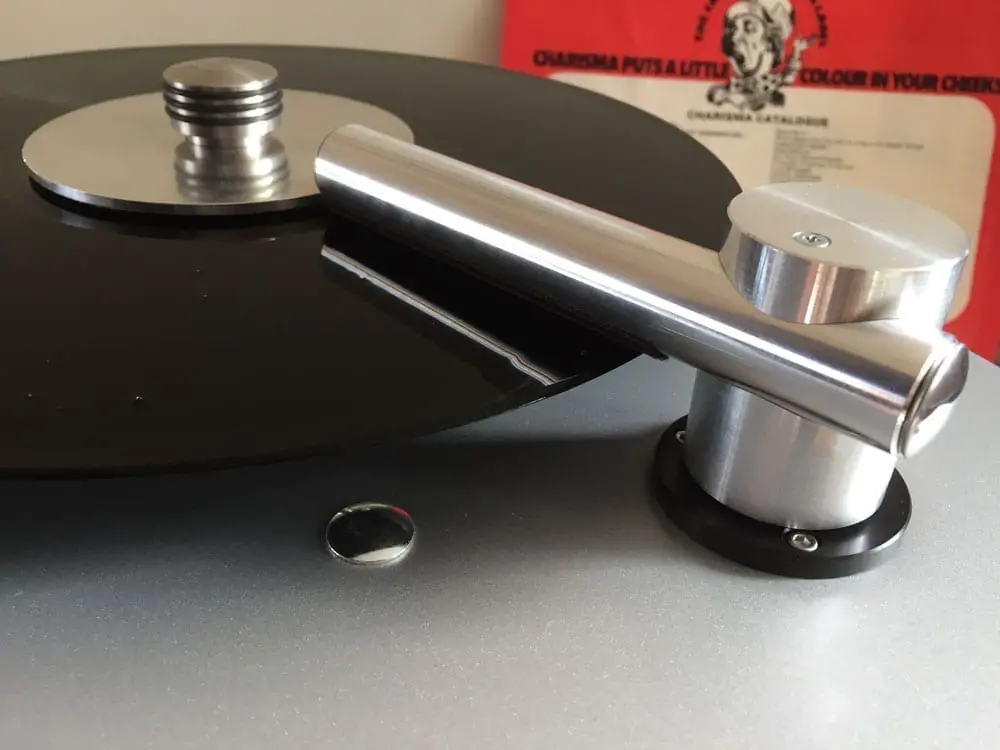
Ultrasonic Cleaning
Got a few bucks to spare? Ultrasonic cleaning is arguably the most effective and least abrasive way to clean records. Ultrasonic cleaning works by using ultrasound to agitate a liquid, producing tiny cavitation bubbles. Lots of tiny bubbles produce high forces, helping to gently lift contaminants adhering to the record surface.
The only drawback? Price. A purpose-built ultrasonic record cleaner can set you back thousands. As an affordable alternative, there are companies that manufacture record adaptors for use with commercially available ultrasonic cleaning tanks. You can read more about those here.
Stylus Maintenance
A worn stylus can permanently damage your records. If you’re unsure about the condition, play on the safe side and replace it. As a matter of practice, I replace my stylus at least once every year. How long a stylus will last depends on how many records you play, the condition of your records, and how well you maintain the stylus with regular cleaning. On average, a diamond stylus tip will typically last between 800 and 1000 playing hours. (That’s a best-case scenario of about four records per day).
To help your stylus stay in tip-top condition for as long as possible, avoid playing damaged or very dirty records, and make a habit of cleaning your stylus regularly. For this, you’ll need a stylus cleaner (I use the SC1 GrooveWasher solution) to gently remove dirt. When doing so, always handle with care and gently pull the brush from back to front to ensure you don’t damage the delicate stylus shank. (Once again, you can get 10% off with the code SOUNDMATTERS10)
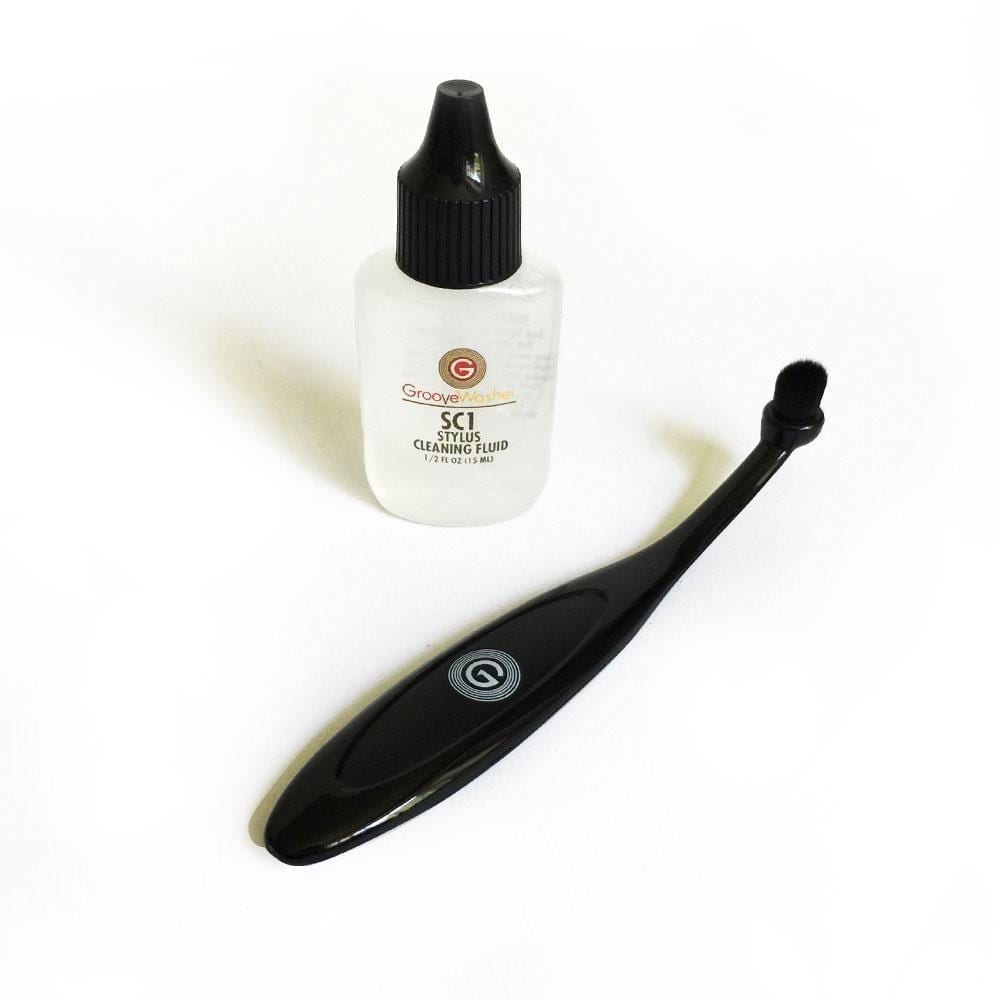
Some folks argue that stylus cleaning fluid and brushes may pose a risk to the cartridge and stylus shank. I have never experienced any issues personally, but if fluid-based stylus cleaning concerns you, consider a gel-based stylus cleaner, such as the Onzow Zero Dust.
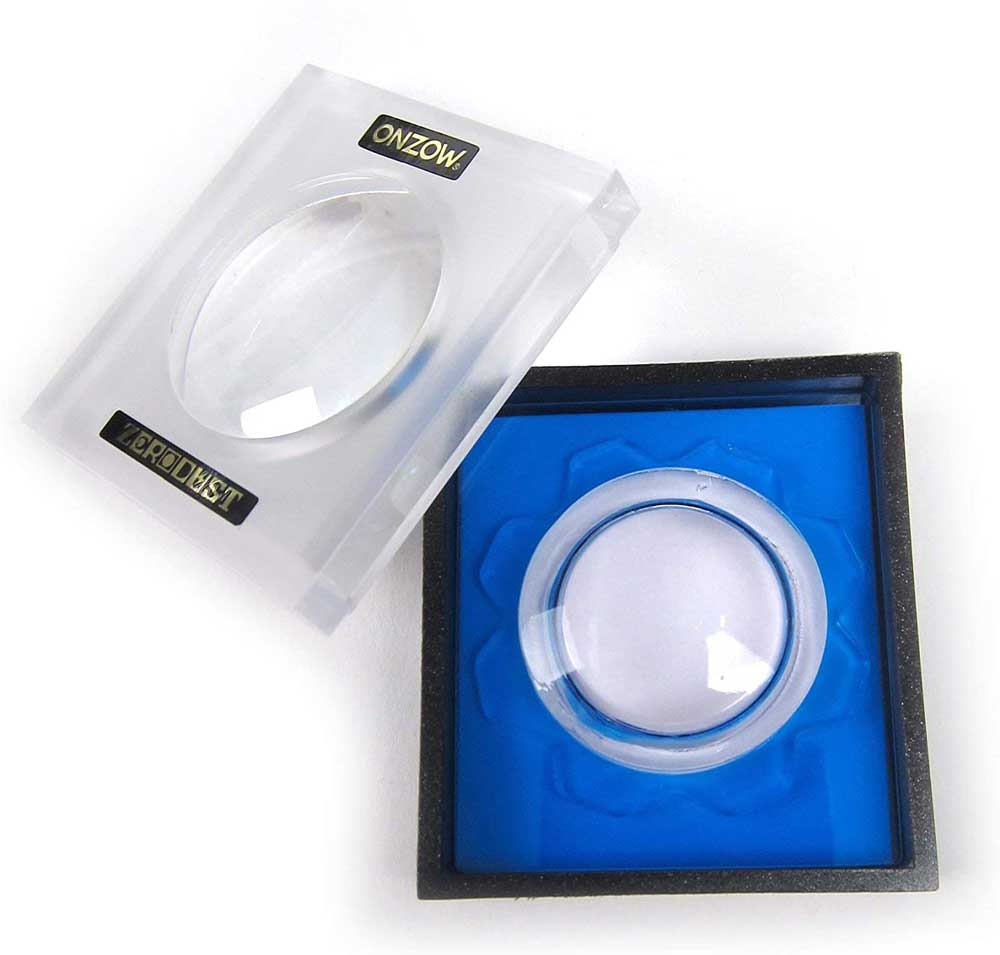
The product might look a little crazy and space-age, but it’s a great low-contact method for cleaning your stylus. It features a specially developed ultra-soft plastic that lightly clings to anything it touches. Simply allow your tonearm to drop gently into the lowered position, then carefully press the Zero Dust up towards the stylus and pull away to leave your stylus clean and clear. As a bonus, the Zero Dust doubles up as a magnifier, which is handy for stylus inspection.
Controlling Static
When it comes to keeping your records dust-free, controlling static is half the battle. Depending on the environment where you live, static electricity could be a small irritant, or a major headache. The problem is most acute in dry climates when the humidity is low; this is because the surface moisture on materials makes for a good conductor.
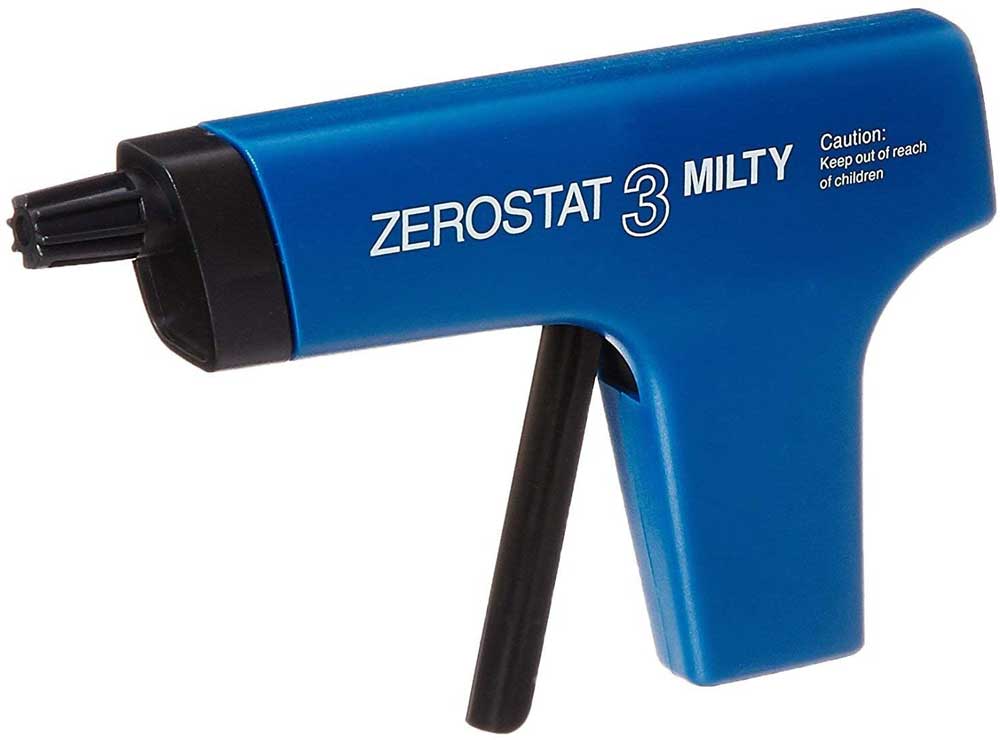
If static becomes persistent and problematic, you should consider purchasing an antistatic gun. Despite looking like an over-priced children’s toy, the Zerostat Antistatic gun is highly effective, and a must-have tool in any record collector’s arsenal. This antistatic gun incorporates a Piezo Crystal device that produces negative and positive ions that couple with the positive and negative static charges on the record surface to neutralize static. It sounds like witchcraft, but it works.
Another way you can significantly reduce the build-up of static and dust is by ditching your standard felt turntable mat for cork. The standard felt mat supplied with many turntables collects dust and dirt through static charge, which in turn is transferred to your records causing undesirable pops and click. A cork mat is less prone to static and also improves sound quality by enhancing contact between the record surface and turntable platter. I use the Project one.
Better still, if your turntable manufacturer provides the option to upgrade your platter for an acrylic model, this will allow you to place the record directly onto the platter, thus eliminating the need for a mat altogether. Whichever surface you choose for your platter or mat, they all have pros and cons – you can read more about this topic, here.
Turntable Setup & Maintenance
Equally important on the maintenance front is the correct setup of your turntable. A poorly aligned cartridge, for example, can irreparably damage your vinyl.
If you’ve purchased a new turntable, you may be in luck, as many of them now come set up with the cartridge pre-fitted and aligned. A used turntable, on the other hand, will almost certainly require setting up or even servicing. In any case, it’s still best you double-check a few basics before spinning your records. At the very least, you should check the condition of the stylus, the cartridge alignment, the anti-skate (bias) setting, and your tracking force.
Firstly, let’s take a look at cartridge alignment. Having correct alignment is crucial as it affects how your stylus tracks the groove from start to finish of each side. If the alignment is out, your stylus could be applying excess pressure to the walls of your record grooves, and subsequently, cause damage. Most cartridges ship with a cardboard alignment protractor, but if you don’t have one, there are lots of templates available to download at vinylengine.com
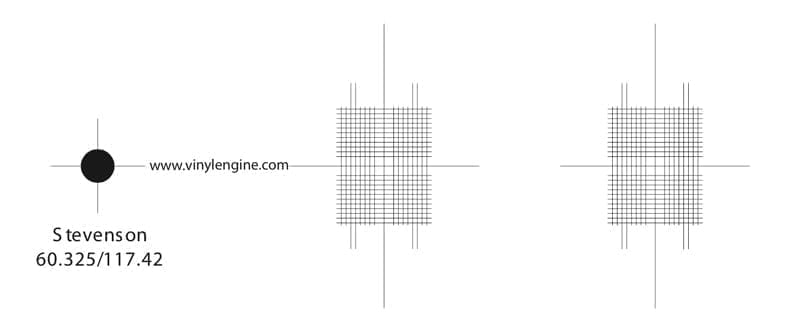
Alternatively, you could purchase a perspex alignment protractor. Some have a mirrored surface, which is said to help with alignment in some instances.
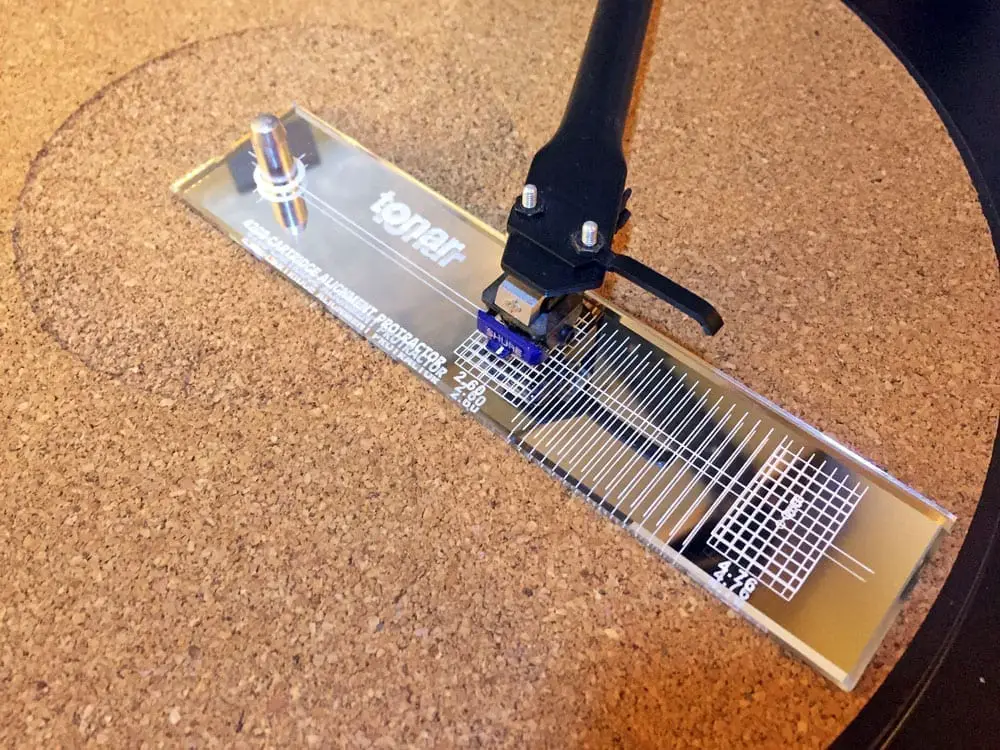
Always set your tonearm counterweight in accordance with your cartridge requirements. If the weight is not set correctly, you could suffer a loss of performance or even be causing record wear. You could set this the old-school way by at first balancing the tonearm so that it hovers, and then using the number dial at the counterweight. However, by-far a more accurate way of setting downforce is to use a tracking force gauge. Modern digital versions are cost-effect and more than adequate.
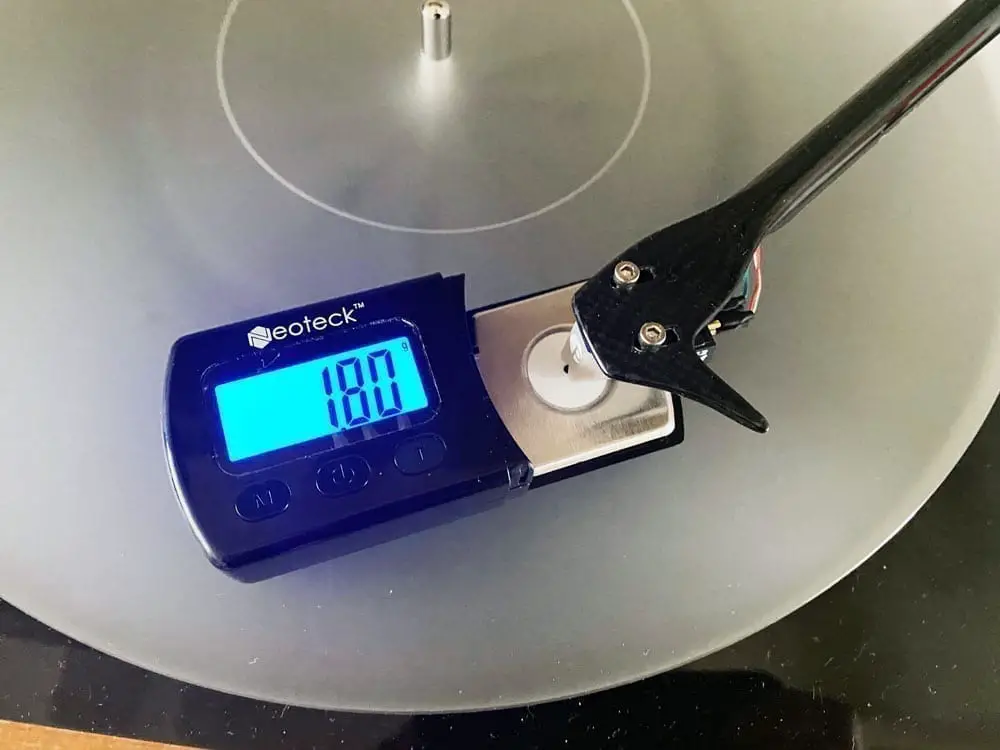
Finally – and often misunderstood – is the anti-skate (or bias) setting. In a nutshell, when the anti-skate is set correctly, the applied counterforce will correct the tonearm’s natural tendency to pull in towards the center spindle and prevents your stylus from ridding up the side of the groove. Instead, the stylus will sit centrally for more accurate tracking and less record wear.
For a detailed step-by-step guide on how to set up your turntable, consider reading our complete guide.
The Importance of a Great Turntable
Amazingly, record players were one of Amazon’s biggest sellers last Christmas, which would certainly suggest the Vinyl trend isn’t going anywhere fast. The problem is, most of these turntables were cheap, low-quality offerings for under $100. While some of these devices have their place as throwback nostalgia items, they’re certainly not conducive to great sounding, well looked after records.
In my experience, cheap record players are poorly set up, come with cheap sapphire styli, and sound poor. At the end-of-the-day, we’re talking about a playback mechanism that works on a microscopic level, and any misplacement could play havoc with your precious grooves over time. The long and short of it is this: your turntable needs to be meticulously engineered.
So does that mean a low-budget can’t yield good results for low record wear? Absolutely not…
I’ll level with you; I don’t have a big budget to spend on my vinyl hobby. At first, I started out with a cheap Marantz deck with the pre-amp included. It was a nightmare; the thing skipped – even when playing new records – and some of my earlier purchases suffered permanent damage as a result of playing them on this system. I quickly realized that while I had to keep within a reasonable budget, there was a limit. I swiftly returned the first deck for something less feature-rich, but with all the basics just right. If you’re playing your records on a cheap setup, it won’t matter if you follow all the advice in this guide, your records (and sound quality) will ultimately suffer.
Check out our list of the best budget to mid-range turntables for a list of recommended models to suit most budgets.
The Bottom Line
There is a certain magic and allure to vinyl that has seen the format endure much change over the last three decades. Purists love the format for its physical connection. And, with the right maintenance and care, vinyl records can go on delivering for many years to come – providing what I feel is certainly the most romantic way to consume music.
Vinyl is certainly not without its faults. But nevertheless, if you like the physical product and you’re prepared to put in a little extra groundwork to maintain your records – collecting vinyl can be one of the most rewarding ways to consume music.
Last but by no means least, if you’re new to the vinyl hobby, it’s advisable to understand how to play a record correctly without causing damage if you want to look after your records for the long term.

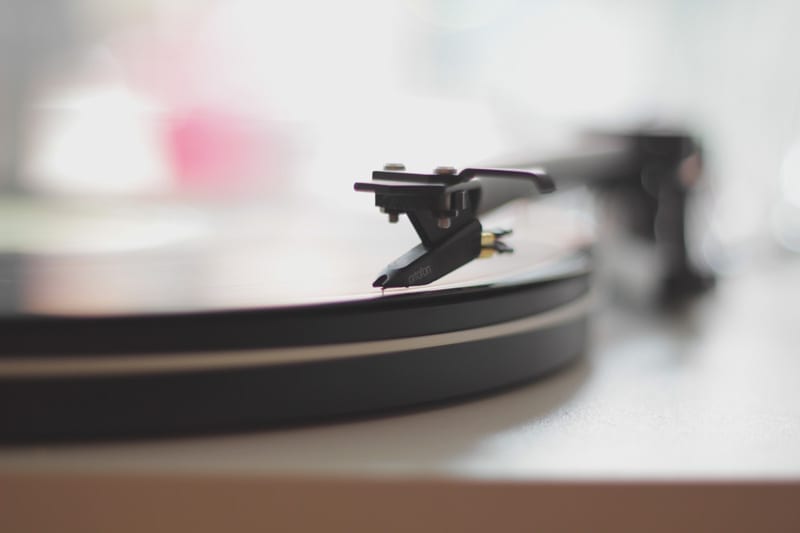




Great tips! It doesn’t take too much effort to take proper care of your records, as long as you’ve got the right accessories such as sleeves, brushes and cleaners. If you’re in Australia you can find them online or if you’re in Melbourne you can pop in store, just visit https://www.funkyduckvinyl.com
[…] you want to enhance the sound of the music that you play on the record player, you will need some accessories to finish the job. In most cases, you can purchase these through […]
[…] As it turns out, well-taken care of vinyl records can last a lifetime. But the very thing that makes folks love the sound tone and feel of vinyl is what makes them difficult to take care of well. How do you to it? Here are some tips from Your Sound Matters: […]
[…] best way to prevent future issues is to store your vinyls with a protective sleeve. This will reduce the amount of dust that will attach to the vinyl. For additional protection, you […]
[…] in the record grooves, and this manifests as the infamous pops and clicks we all know. Clearly, good practice record care will help you keep the build-up of dirt to a minimum, but if you’re able to keep your records […]
[…] őket és törekedni arra, hogy minél kevesebbet tartózkodjanak szabad levegőn. Kép: Sound Matter A tárolásnál figyeljünk arra is, hogy ezek sérülékeny tárgyak, melyek súly hatására […]
[…] some time, we’ve recommended MoFi inner record sleeves as part of your day-to-day vinyl record care; and that recommendation still stands, they’re great quality sleeves. Sadly, most new vinyl […]
[…] a detailed guide on how to look after your vinyl records, how to clean vinyl records, and store your collection, consider starting with the Sound […]
Nice Suggestions!! Maintaining records for a long time is a big and challenging task. Thanks for sharing informative tips. We can also use sleeves and many other accessories for protecting records from any damage. Nowadays many good options are available online. If you are in Melbourne, you need not to worry about it. Visit: https://www.dutchvinyl.com.au.
I regularly use the Spin Clean Record Washer. For me it’s the best option for vinyl records cleaning.
[…] There’s no denying it, vinyl records require a great deal of care and attention to maintain in great condition. If you want your music maintenance free, vinyl probably isn’t the format for you. To properly maintain a record collection you’ll need to understand how to store your vinyl records to prevent deterioration or damage, you’ll need to perform some routine cleaning form time-to-time, and, you’ll need to get a grip on some basic turntable setup and maintenance tasks. No one said it would be easy, but in my experience, nothing worth doing ever is. To learn the basics vinyl record care and maintenance, check out our previous article. […]
[…] http://www.soundmattersblog.com/how-to-look-after-your-vinyl-records/ […]
[…] original sleeves will protect your vinyl to an extent, but dust and dirt are drawn to the grooves. Sound Matters recommends using polyethylene sleeves to provide an additional barrier against […]
[…] can read more about complete record care in our previous post, but for today, we’re going to turn our heads specifically to keeping […]
[…] also learning how maintenance comes with the territory. As we’ve already established in our first post about vinyl record care – great sounding records require care and attention. In this second edition, we’ll cover […]
[…] simple message here is, look after your records and turntable, and you’ll ultimately be rewarded with great sound quality for much longer. […]
1000 hours that works out to 1500 records played both sides,I did the math for you based on 20 minutes playing time per side
[…] keeping them clean and clear of dust, they can be a real pain in the neck. There are many ways to keep your vinyl records clean and sounding great, the most affordable of which is a good cleaning solution. Previously, […]
The Squeaky Clean Vinyl Mark III and Pocket RCM are great cleaners at low prices. You supply the vacuum.
Clear Groove is really great stuff. Been using it for quite a few years now. Ive noticed quite a few copycat products though so make sure it says Clear Groove on the bottle and not just something simular! . Im also a big fan of sealable poly sleeves too and my whole collection is in them! U can get em quite cheap. I would love one of those new ultra sleek vacuming machines. Bet that would work wonders with the Clear Groove fluid too : )
Hey Paul. Yea, I’ve found it works for me. Those vacuum systems are ideal, but expensive. The spin clean works for me as a compromise (particularly in a small house!). Thanks for your comment – happy listening 🙂
Well done! Please do more, including siting the turntable…avoiding speaker vibration, floor vibration and inebriated folks!
Thanks James, really appreciate the kind words. I’ve noted your suggestions for future posts. Cheers!
[…] Even the most carefully looked after records will benefit from a wet clean once in a while. And, if you’re playing old or used records in any capacity, a good clean will almost certainly be in order before you subject them to your shiny new setup. Clear groove record cleaning solution is a good place to start on a budget for restoring old or dirty records. More on record care and maintenance in our previous post. […]
[…] and done, vinyl has its unique characteristics that some listeners prefer. But, it also comes with its own set of challenges and some extra […]